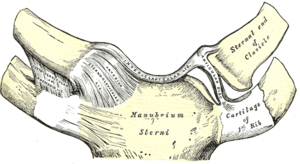We need you! Join our contributor community and become a WikEM editor through our open and transparent promotion process.
Sternoclavicular dislocation
From WikEM
Contents
Background
- Very stable joint making a dislocation rare; majority of injuries are simple sprains
- Dislocations usually require severe force (MVC, sports injuries)
- Mechanism either direct blow to the chest, or lateral compression
- Anterior dislocations are much more common than posterior
- Due to both force and anatomic location, damage to the brachial plexus, subclavian, trachea, and esophagus may occur[1]
- Trivia - SC joint is only true articulation between the upper extremity and the axial skeleton
Clinical Features
Sprain
- Pain and swelling are localized to the joint
Dislocation
- Severe pain that is exacerbated by arm motion and lying supine
- Shoulder appears shortened and rolled forward
- Anterior dislocation: prominent medial clavicle end is visible/palpable ant to sternum
- Posterior dislocation: Medial end is less visible and often not palpable
- If there is delay in presentation, edema may have developed making depression of the medial head less obvious
Differential Diagnosis
Thoracic Trauma
- Airway/Pulmonary
- Cardiac/Vascular
- Musculoskeletal
- Clavicle fracture
- Flail chest
- Rib fracture
- Scapula fracture
- Scapulothoracic dissociation
- Sternoclavicular dislocation
- Sternum fracture
- Other
Evaluation
- CT
- Study of choice (plain films may not be diagnostic)
- Consider IV contrast if concern for injury to mediastinal structures
- Serendipity view Xray
- Xray taken at a 40 degree cephalic tilt may be useful if CT unavailable.[1]
- MRI is a consideration, though less likely to be practical
Management
- Symptoms of stridor, shortness of breath, or dysphagia, indicate aerodigestive tract injury and require immediate reduction. Also immediately reduce if evidence of vascular occlusion.
Sprain
- Rice, sling, analgesics
Anterior Dislocation
- May discharged without attempted reduction (no impact on function)
- Clavicular splinting, ice, analgesics
- Ortho referral within several days
Posterior Dislocation
- May be associated with life-threatening injuries:
- Pneumothorax, compression/laceration of surrounding great vessels, trachea, or esophagus
- Consult ortho for closed reduction (ideally performed in the OR or under Procedural Sedation)
- Reduction must be performed with Cardiothoracic Surgery on-call or nearby due to potential for great vessel injury during reduction / manipulation
- Create a sterile field with appropriate skin prep.
- A metal towel clip is inserted percutaneously and is used to grasp the medial clavicle, pulling anteriorly until reduction is complete
- May be observed afterwards due to severity of trauma and risk for vascular injury[2]
Disposition
- Anterior dislocation
- Ortho follow up within several days
- Posterior dislocation
- Immediate ortho consult, with potential transfer to facility with BOTH Ortho and CT surgery
References
- ↑ 1.0 1.1 Balcik BJ et al. Evaluation and treatment of sternoclavicular, clavicular, and acromioclavicular injuries. Prim Care Clin Office Pract 40 (2013): 911-923. PMID: 24209725
- ↑ Deren ME et al. Posterior sternoclavicular dislocations: a brief review and technique for closed management of a rare but serious injury. Orthopedic Reviews 2014; 6: 5245. PMID: 24744842

